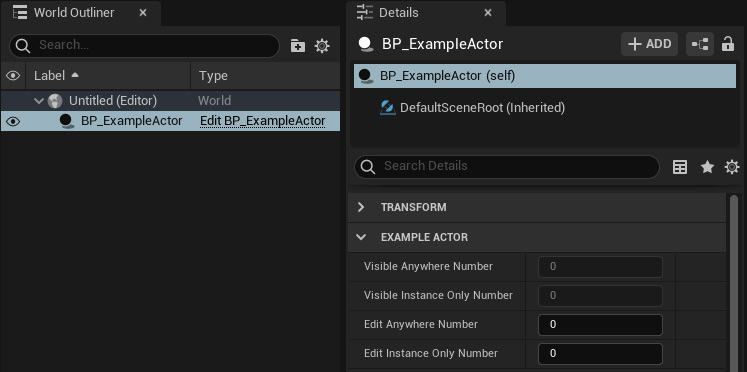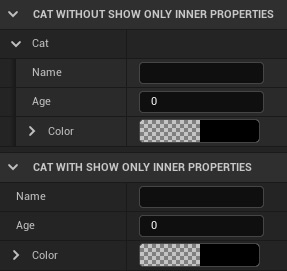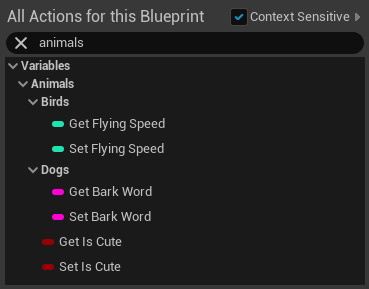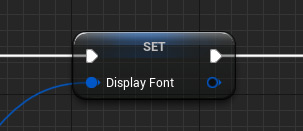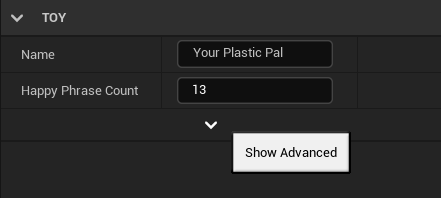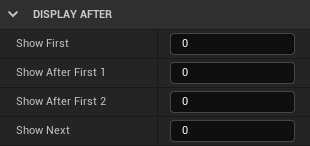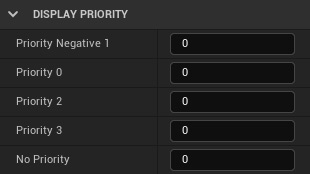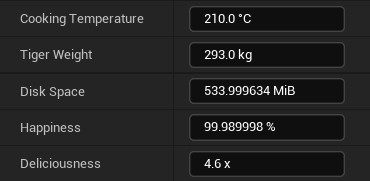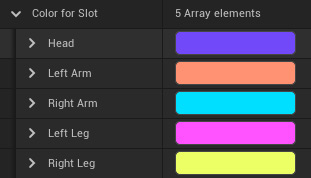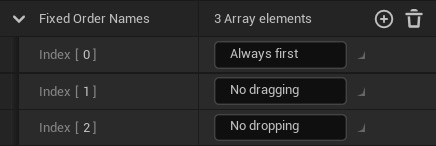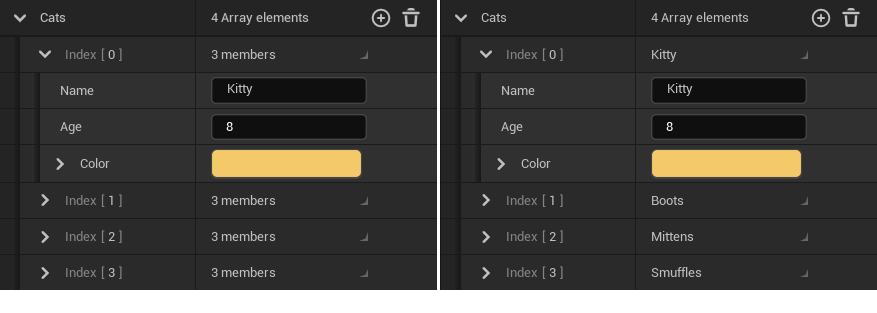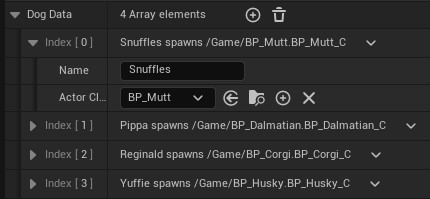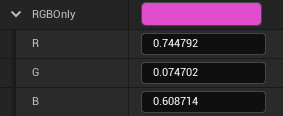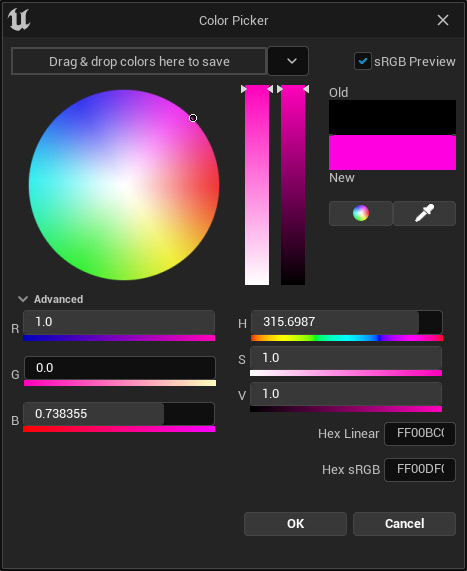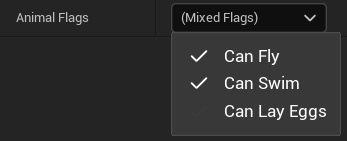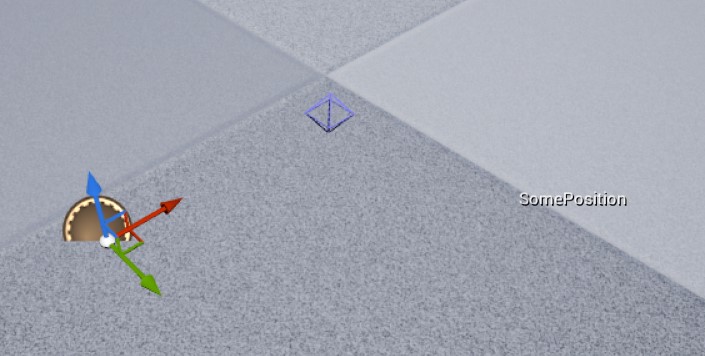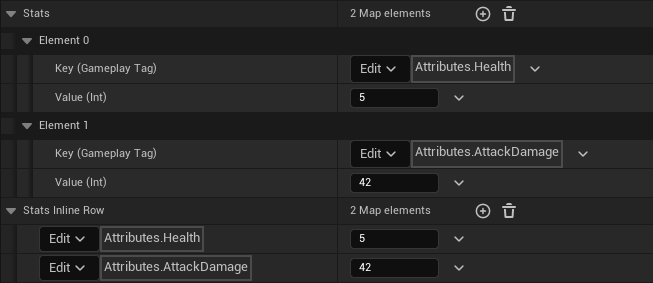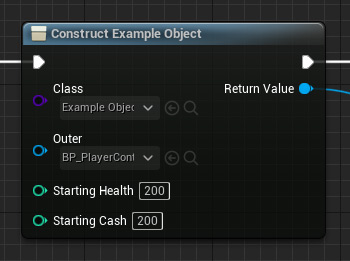UE DataDecorators-UPROPERTY
Editor
Visibility
$UPROPERTY($VisibleAnywhere$)$
Position: $ Main $
Type: $ flag $
Incompatible with:
Properties marked with VisibleAnywhere are visible in the both Details Panel of Blueprint assets and the Details Panel of Blueprint instances within maps. Note that this refers to being visible in the Details Panel, not visible in the Blueprint Graph. For that you need to use BlueprintReadOnly.
Indicates that this property is visible in all property windows, but cannot be edited. This Specifier is incompatible with the “Edit” Specifiers. Unreal Documentation
1
2
UPROPERTY(VisibleAnywhere)
int32 VisibleAnywhereNumber;
$UPROPERTY($ VisibleDefaultsOnly $)$
Position: $ Main $
Type: $ flag $
Incompatible with:
“Defaults” in this context means that this property will be visible in Blueprint classes (e.g. the BP_Cat asset in your content browser), but not instances (e.g. Cat in your map).
You might want to make a property VisibleDefaultsOnly if it is defined and used in C++, but Blueprint users may want to see the value of it when editing the Blueprint asset itself. It is effectively a way of making a property visible but read-only.
Note that this refers to being visible in the Details panel, not visible through the Blueprint Graph. For that you need to use BlueprintReadOnly.
Indicates that this property is only visible in property windows for archetypes, and cannot be edited. This Specifier is incompatible with any of the “Edit” Specifiers. Unreal Documentation
1
2
UPROPERTY(VisibleAnywhere)
int32 VisibleAnywhereNumber;
$UPROPERTY($ VisibleInstanceOnly $)$
Position: $ Main $
Type: $ flag $
Incompatible with:
This property will only be visible in Blueprint instances, like those that exist in the map.
This is a more rarely-used visibility specifier, but you could maybe use it for showing Blueprint users the values of properties that are defined in C++ or are calculated based on other properties.
Note that this refers to being visible in the Details panel, not visible through the Blueprint Graph. For that you need to use BlueprintReadOnly.
Indicates that this property is only visible in property windows for instances, not for archetypes, and cannot be edited. This Specifier is incompatible with any of the “Edit” Specifiers. Unreal Documentation
1
2
UPROPERTY(VisibleInstanceOnly)
int32 VisibleInstanceOnlyNumber;
$UPROPERTY($ EditAnywhere $)$
Position: $ Main $
Type: $ flag $
Incompatible with:
Related:
The value of EditAnywhere properties can be changed in both the Details Panel of Blueprint assets and the Details Panel of Blueprint instances.
Note that this refers to being editable in the Details panel, not visible through the Blueprint Graph. For that you need to use BlueprintReadWrite.
Indicates that this property can be edited by property windows, on archetypes and instances. This Specifier is incompatible with any of the the “Visible” Specifiers. Unreal Documentation
1
2
UPROPERTY(EditAnywhere)
int32 EditAnywhereNumber;
$UPROPERTY($ EditInstanceOnly $)$
Position: $ Main $
Type: $ flag $
You might want to make a property EditInstanceOnly if it does not make sense to have a default value in the Blueprint asset. For example a ATrigger actor could point to ADoor instances within a map and tell them to open when the trigger is activated. In this example it would not make sense to have TArray<ADoor*> be editable within the Blueprint asset, so you could use EditInstanceOnly.
Note that this refers to being editable in the Details panel, not visible through the Blueprint Graph. For that you need to use BlueprintReadWrite.
Indicates that this property can be edited by property windows, but only on instances, not on archetypes. This Specifier is incompatible with any of the “Visible” Specifiers. Unreal Documentation
1
2
UPROPERTY(EditInstanceOnly)
int32 EditInstanceOnlyNumber;
$UPROPERTY($ EditDefaultsOnly $)$
Position: $ Main $
Type: $ flag $
Incompatible with:
Related:
Indicates that this property can be edited by property windows, but only on archetypes. This Specifier is incompatible with any of the “Visible” Specifiers. Unreal Documentation
1
2
UPROPERTY(EditDefaultsOnly)
int32 EditDefaultsOnlyNumber;
$UPROPERTY(meta=($ HideInDetailPanel $))$
Position: $ Meta $
Type: $ flag $
Requires:
Not sure this is very useful for anything. Events are not really shown in a useful way in the details panel. The green + shape button that is shown on UButton is a UMG-specific editor customization so this does not relate to showing events in that way.
Indicates that the property should be hidden in the details panel. Currently only used by events. Unreal Documentation
$UPROPERTY(meta=($ ShowOnlyInnerProperties $))$
Position: $ Meta $
Type: $ flag $
Useful when you want to avoid making users click to expand an struct, for example when it is the only thing inside an outer class.
Used by struct properties. Indicates that the inner properties will not be shown inside an expandable struct, but promoted up a level. Unreal Documentation
1
2
3
4
5
6
7
8
9
10
11
12
13
14
15
16
USTRUCT()
struct FCat
{
GENERATED_BODY()
UPROPERTY(EditDefaultsOnly)
FString Name;
UPROPERTY(EditDefaultsOnly)
int32 Age;
UPROPERTY(EditDefaultsOnly)
FLinearColor Color;
};
// ...
UPROPERTY(EditAnywhere, Category="Cat Without ShowOnlyInnerProperties")
FCat Cat;
UPROPERTY(EditAnywhere, Category="Cat With ShowOnlyInnerProperties", meta=(ShowOnlyInnerProperties))
FCat Cat;
Display
$UPROPERTY($ Category = “abc” $)$
Position: $ Main $
Type: $ string $
Using Category, it’s possible to group properties together into expandable folders. The pipe character | can be used to create sub-folders. For example Category="Character Info|Health" would create two folders: Character Info, and within that, Health.
The categories are also used when searching for properties within the Blueprint graph, if they are exposed with BlueprintReadOnly or BlueprintReadWrite.
Note that whitespace is important; if there are two properties one marked with Category="Parent|Child" and one with Category="Parent | Child", it will result in two folders being displayed.
Specifies the category of the property when displayed in Blueprint editing tools. Define nested categories using the | operator. Unreal Documentation
1
2
3
4
5
6
UPROPERTY(EditAnywhere, Category="Animals")
bool bIsCute;
UPROPERTY(EditAnywhere, Category="Animals|Dogs")
FString BarkWord;
UPROPERTY(EditAnywhere, Category="Animals|Birds")
int32 FlyingSpeed = 99;
$UPROPERTY(meta=($ DisplayName $))$
Position: $ Meta $
Type: $ string $
Changes the text label used with the property. This is used both in the Details panel and for
Useful when there are internal programmer-only technical terms that do not need to be shown to the user.
1
2
UPROPERTY(EditAnywhere, meta=(DisplayName="Display Font"))
FSoftObjectPath DisplayFontPath;
$UPROPERTY(meta=($ ToolTip $))$
Position: $ Meta $
Type: $ string $
Show a tooltip with this text when mousing over the property.
1
2
3
UPROPERTY(EditAnywhere, meta=(ToolTip="Something that's shown when hovering."))
int32 Legs;
$UPROPERTY($ AdvancedDisplay $)$
Position: $ Main $
Type: $ flag $
Incompatible with:
Opposite:
Any properties with AdvancedDisplay are hidden under a section that is opened with a dropdown arrow.
Useful for separating properties that are rarely used or only useful to advanced users.
The property will be placed in the advanced (dropdown) section of any panel where it appears. Unreal Documentation
1
2
3
4
5
6
UPROPERTY(EditAnywhere, Category="Toy")
FString Name;
UPROPERTY(EditAnywhere, Category="Toy")
int32 HappyPhraseCount;
UPROPERTY(EditAnywhere, Category="Toy", AdvancedDisplay)
bool bEnableEvilMode;
$UPROPERTY($ SimpleDisplay $)$
Position: $ Main $
Type: $ flag $
Incompatible with:
Opposite:
Visible or editable properties appear in the Details panel and are visible without opening the “Advanced” section. Unreal Documentation
$UPROPERTY(meta=($ ShowInnerProperties $))$
Position: $ Meta $
Type: $ flag $
Related:
Seems to be used for object references, whereas ShowOnlyInnerProperties is used for Structs? EditInline or Instanced seems to be co-occurrent.
$UPROPERTY(meta=($ FullyExpand $))$
Position: $ Meta $
Type: $ bool $
$UPROPERTY(meta=($ EditCondition $))$
Position: $ Meta $
Type: $ string (Conditional statement) $
Related:
EditCondition can be used to change a property from read-only to writeable depending on another property.
The simplest way is simply using another bool property, but as of 4.23 more complex statements are supported.
It is worth noting that EditCondition also changes the appearance of properties inside Blueprint logic Make Struct nodes.
1
2
3
4
5
6
7
8
9
10
11
12
13
14
15
16
17
18
19
UPROPERTY(EditAnywhere)
bool bCanFly;
UPROPERTY(EditAnywhere, meta=(EditCondition="bCanFly"))
float MaxFlightSpeed;
UENUM()
enum class EAnimalType
{
Bird,
Fish
};
UPROPERTY(EditAnywhere)
EAnimalType AnimalType;
UPROPERTY(EditAnywhere, meta=(EditCondition="AnimalType==EAnimalType::Bird"))
float MaxFlightSpeed;
UPROPERTY(EditAnywhere, meta=(EditCondition="AnimalType==EAnimalType::Fish"))
float MaxSwimSpeed;
$UPROPERTY(meta=($ HideEditConditionToggle $))$
Position: $ Meta $
Type: $ flag $
$UPROPERTY(meta=($ EditConditionHides $))$
Position: $ Meta $
Type: $ flag $
Requires:
By default, EditCondition changes properties to be read-only when the condition evaluates to false. With EditConditionHides, the property is hidden. I find this useful for hiding larger groups of properties.
1
2
3
4
5
6
7
8
9
10
11
12
13
14
15
16
17
18
UENUM()
enum class EPlantType
{
Flower,
Food,
Poison
};
UPROPERTY(EditDefaultsOnly)
EPlantType PlantType = EPlantType::Flower;
UPROPERTY(EditDefaultsOnly, meta=(EditCondition="PlantType==EPlantType::Flower", EditConditionHides))
FLinearColor FlowerColor = FLinearColor::White;
UPROPERTY(EditDefaultsOnly, Category="Food", meta=(EditCondition="PlantType==EPlantType::Food", EditConditionHides))
int32 FoodAmount = 1;
UPROPERTY(EditDefaultsOnly, meta=(EditCondition="PlantType==EPlantType::Poison", EditConditionHides))
float PoisonDamagePerSecond = 0.25f;
$UPROPERTY(meta=($ InlineEditConditionToggle $))$
Position: $ Meta $
Type: $ flag $
Requires:
Incompatible with:
Opposite:
Related:
Instead of showing the bool property separately, it is instead displayed inline, to the left of the property that it is controlling. Note that this meta flag should be put on the bool property, not the property with the EditCondition
Signifies that the bool property is only displayed inline as an edit condition toggle in other properties, and should not be shown on its own row. Unreal Documentation
1
2
3
4
5
UPROPERTY(EditAnywhere, meta=(InlineEditConditionToggle))
bool bCanFly;
UPROPERTY(EditAnywhere, meta=(EditCondition="bCanFly", Units="s"))
float FlapPeriodSeconds;
$UPROPERTY(meta=($ DisplayAfter $))$
Position: $ Meta $
Type: $ string (Property name) $
Related:
Multiple properties with DisplayAfter that refer to the same property will be displayed in the order they are defined.
Indicates that the property should be displayed immediately after the property named in the metadata. Unreal Documentation
1
2
3
4
5
6
7
8
UPROPERTY(EditAnywhere, meta=(DisplayAfter="ShowFirst"))
int32 ShowAfterFirst1;
UPROPERTY(EditAnywhere, meta=(DisplayAfter="ShowFirst"))
int32 ShowAfterFirst2;
UPROPERTY(EditAnywhere)
int32 ShowFirst;
UPROPERTY(EditAnywhere)
int32 ShowNext;
$UPROPERTY(meta=($ DisplayPriority $))$
Position: $ Meta $
Type: $ integer $
Related:
Changes the order in which properties are shown within a category. Properties with lower numbers are shown before those with higher numbers.
Properties without a DisplayPriority tag are given a default value of MAX_int32 and displayed after all properties with a tag.
Negative values are allowed.
Internally is converted from a string to an integer with FCString::Atoi.
The relative order within its category that the property should be displayed in where lower values are sorted first. Unreal Documentation
1
2
3
4
5
6
7
8
9
10
UPROPERTY(EditAnywhere, meta=(DisplayPriority=3))
int32 Priority3;
UPROPERTY(EditAnywhere, meta=(DisplayPriority=2))
int32 Priority2
UPROPERTY(EditAnywhere, meta=(DisplayPriority=0))
int32 Priority0;
UPROPERTY(EditAnywhere)
int32 NoPriority;
UPROPERTY(EditAnywhere, meta=(DisplayPriority=-1)
int32 PriorityNegative1;
$UPROPERTY(meta=($ DisplayThumbnail $))$
Position: $ Meta $
Type: $ bool $
Related:
Can also be used as metadata on UCLASS().
Indicates that the property is an asset type and it should display the thumbnail of the selected asset. Unreal Documentation
1
2
3
4
5
UPROPERTY(EditAnywhere, meta=(DisplayThumbnail=false))
class UCurveFloat* SomeCurve;
UPROPERTY(EditAnywhere, meta=(DisplayThumbnail=true))
TSoftObjectPtr<USkeletalMesh> AnimalMesh;
$UPROPERTY(meta=($ MaxPropertyDepth = 123 $))$
Position: $ Meta $
Type: $ integer $
You can use this to limit the depth to which nested properties are shown. It might be useful if you have structs within structs within structs to an extreme degree.
No examples of this in the source code as far as I can tell.
Undo and Redo
$UPROPERTY($ NonTransactional $)$
Position: $ Main $
Type: $ flag $
Indicates that changes to this property’s value will not be included in the editor’s undo/redo history. Unreal Documentation
Misc
$UPROPERTY(meta=($ ForceRebuildProperty $))$
Position: $ Meta $
Type: $ string $
Seems to find a child property node with the specified string, and if found, force them to be rebuilt
$UPROPERTY($ Instanced $)$
Position: $ Main $
Type: $ flag $
Related:
Object (
UCLASS) properties only. When an instance of this class is created, it will be given a unique copy of the Object assigned to this property in defaults. Used for instancing subobjects defined in class default properties. ImpliesEditInlineandExport. Unreal Documentation
1
2
3
4
5
6
7
8
9
10
11
12
13
14
15
16
17
18
UCLASS(EditInlineNew, DefaultToInstanced, CollapseCategories)
class UBeamInstanceSettings : public UObject
{
GENERATED_BODY()
public:
UPROPERTY(EditAnywhere)
int32 MyOption;
};
UCLASS()
class ABeamTrackEmitter : public AActor
{
GENERATED_BODY()
public:
UPROPERTY(BlueprintReadOnly, Instanced)
UInstanceSettings* Settings;
};
$UPROPERTY(meta=($ ExposeFunctionCategories=”abc” $))$
Position: $ Meta $
Type: $ string (UFUNCTION category names?) $
Seems to be used for exposing components within actors.
Specifies a list of categories whose functions should be exposed when building a function list in the Blueprint Editor. Unreal Documentation
1
2
3
4
UPROPERTY(VisibleAnywhere, BlueprintReadOnly, meta=(ExposeFunctionCategories="PointLight,Rendering|Lighting"))
TObjectPtr<class UPointLightComponent> PointLightComponent;
UPROPERTY(VisibleAnywhere, BlueprintReadOnly, meta=(ExposeFunctionCategories = "Mesh,Rendering,Physics,Components|StaticMesh", AllowPrivateAccess = "true"))
class UStaticMeshComponent* StaticMeshComponent;
Internal and Deprecated
$UPROPERTY(meta=($ EditInline $))$
Position: $ Meta $
Type: $ flag $
Related:
Using this shows the error “EditInline is deprecated. Remove it, or use Instanced instead.”
Allows the user to edit the properties of the Object referenced by this property within Unreal Editor’s property inspector (only useful for Object references, including arrays of Object reference). Unreal Documentation
1
2
UPROPERTY(EditAnywhere, meta=(EditInline))
UDog* Dog;
¥UPROPERTY($ RepRetry $)$
Position: $ Main $
Type: $ flag $
As of Unreal 5.0 Early Access 2, RepRetry is marked as deprecated.
Only useful for struct properties. Retry replication of this property if it fails to be fully sent (for example, Object references not yet available to serialize over the network). For simple references, this is the default, but for structs, this is often undesirable due to the bandwidth cost, so it is disabled unless this flag is specified. Unreal Documentation
$UPROPERTY($ Localized $)$
Position: $ Main $
Type: $ flag $
This is mentioend in the documentation, but it’s deprecated. And it’s not used anywhere in the engine. If you’re looking for localization stuff start with FText.
The value of this property will have a localized value defined. Mostly used for strings. Implies
ReadOnly. Unreal Documentation
$UPROPERTY(meta=($ FixedIncrement $))$
Position: $ Meta $
Type: $ integer $
Related:
Probably superceded by Delta?
Deprecated. Unreal Documentation
$UPROPERTY(meta=($ NeedsLatentFixup $))$
Position: $ Meta $
Type: $ flag $
(Internal use only) Used for the latent action manager to fix up a latent action with the VM Unreal Documentation
$UPROPERTY(meta=($ LatentCallbackTarget $))$
Position: $ Meta $
Type: $ flag $
(Internal use only) Used for the latent action manager to track where it’s re-entry should be Unreal Documentation
Data Decorators
General
$UPROPERTY(meta=($ NoResetToDefault $))$
Position: $ Meta $
Type: $ flag $
This hides the little return arrow that is shown to reset a value back to the value defined in the parent Blueprint or C++ class. This can be especially useful for large structs or arrays, where you would want to avoid people being able to accidentally wipe the entire contents.
Property wont have a ‘reset to default’ button when displayed in property windows Unreal Documentation
1
2
3
4
UPROPERTY(EditAnywhere, meta=(NoResetToDefault))
int32 NoResetToDefault = 1;
UPROPERTY(EditAnywhere)
int32 HasResetToDefault = 1;
Numeric
$UPROPERTY(meta=($ ClampMin $))$
Position: $ Meta $
Type: $ number (float, int) $
Related:
ClampMax and ClampMin force numbers entered into the property to be clamped within the specified range.
In comparison, UIMax and UIMin stop the number from going outside the bounds when the user drags their mouse, but still allows them to type in a number outside the UIMin/UIMax range.
Used for float and integer properties. Specifies the minimum value that may be entered for the property. Unreal Documentation
1
2
UPROPERTY(EditAnywhere, meta=(ClampMin=1))
int32 MaxHP;
$UPROPERTY(meta=($ ClampMax=123 $))$
Position: $ Meta $
Type: $ number (float, int) $
Related:
ClampMax and ClampMin force numbers entered into the property to be clamped within the specified range.
In comparison, UIMax and UIMin stop the number from going outside the bounds when the user drags their mouse, but still allows them to type in a number outside the UIMin/UIMax range.
Used for float and integer properties. Specifies the maximum value that may be entered for the property. Unreal Documentation
1
2
3
UPROPERTY(EditAnywhere, meta=(ClampMin=0, ClampMax=100))
int32 RestoreHealthPercent;
$UPROPERTY(meta=($ UIMin = 123 $))$
Position: $ Meta $
Type: $ number (float, int) $
Related:
Setting UIMin stops the user being able to drag the property lower than the specified number. The user can however set the number lower than this value by typing it in. Most of the time it makes sense to use both UIMin and ClampMin.
Used for float and integer properties. Specifies the lowest that the value slider should represent. Unreal Documentation
1
2
UPROPERTY(meta=(UIMin=0, UIMax=100))
int32 PercentScore;
$UPROPERTY(meta=($ UIMax = 123 $))$
Position: $ Meta $
Type: $ number (float, int) $
Related:
Used for float and integer properties. Specifies the highest that the value slider should represent. Unreal Documentation
1
2
UPROPERTY(meta=(UIMin=0, UIMax=100))
int32 PercentScore;
$UPROPERTY(meta=($ NoSpinbox = true $))$
Position: $ Meta $
Type: $ bool $
Without this flag, when mousing over a property input box the cursor will change to show arrows, allowing the user to click and drag to change the value in the input box.
This flag stops that happening.
Note that this is a bool not a flag.
Used for integer and float properties. Indicates that the spin box element of the number editing widget should not be displayed. Unreal Documentation
$UPROPERTY(meta=($ SliderExponent $))$
Position: $ Meta $
Type: $ number (float, int) $
Used by numeric properties. Indicates how rapidly the value will grow when moving an unbounded slider. Unreal Documentation
1
2
UPROPERTY(EditAnywhere, BlueprintReadWrite, Category = "GeometrySettings", AdvancedDisplay, meta = (ClampMin = "0.0001", UIMin = "0.001", UIMax = "2.0", SliderExponent = 6))
float HairTipScale;
$UPROPERTY(meta=($ Delta = 123 $))$
Position: $ Meta $
Type: $ number (float, int) $
Related:
Changes the amount that the number changes when dragging. This does not perform any validation, the user is still free to manually enter a number that is not a multiple of the value. To perform validation, use the Multiple tag.
1
2
3
// Dragging this will make it step up in increments of 12
UPROPERTY(meta=(Delta=12))
int32 TotalEggs;
$UPROPERTY(meta=($ Multiple $))$
Position: $ Meta $
Type: $ number (float, int) $
Related:
Used for numeric properties. Stipulates that the value must be a multiple of the metadata value. Unreal Documentation
1
2
UPROPERTY(meta=(Multiple=12, Delta=12))
int32 TotalEggs;
$UPROPERTY(meta=($ Units = “abc” $))$
Position: $ Meta $
Type: $ string $
Sets a unit to be shown after the number. For all possible values see the TEXT entries in FParseCandidates inside UnitConversion.cpp. Using an unknown value will result in a compile error. Many units have mutliple aliases, for example “Kilometers” and “km” will result in the same unit being used. Units are case-insensitive. Units also allows users to input in related units. Entering 100f into a field with Units="Celsius" results in 37.77779 °C.
1
2
3
4
5
6
7
8
9
10
UPROPERTY(EditAnywhere, meta=(Units="Celsius"))
float CookingTemperature;
UPROPERTY(EditAnywhere, meta=(Units="Kilograms"))
float TigerWeight;
UPROPERTY(EditAnywhere, meta=(Units="GB"))
float DiskSpace;
UPROPERTY(EditAnywhere, meta=(Units="Percent"))
float Happiness;
UPROPERTY(EditAnywhere, meta=(Units="times"))
float Deliciousness;
$UPROPERTY(meta=($ ForceUnits $))$
Position: $ Meta $
Type: $ string $
Related:
Units seems to allow property editors to override the units used to display values. In comparison ForceUnits does not allow any kind of overriding. I would stick to Units to be honest.
$UPROPERTY(meta=($ ArrayClamp $))$
Position: $ Meta $
Type: $ string $
Clamps an integer to be within the range of the specified TArray.
Used for integer properties. Clamps the valid values that can be entered in the UI to be between 0 and the length of the array specified. Unreal Documentation
1
2
3
4
5
UPROPERTY(EditAnywhere)
TArray<FName> Attributes;
UPROPERTY(EditAnywhere, meta=(ArrayClamp="Attributes"))
int32 SelectedAttributeIndex = 0;
$UPROPERTY(meta=($ ValidEnumValues = “abc” $))$
Position: $ Meta $
Type: $ string (Comma-separated values) $
Opposite:
Restricts the allowed enum values to those listed in the string.
1
2
3
4
5
6
7
8
9
10
11
12
13
UENUM()
enum class EBodyPartType : uint8
{
Head,
Body,
LeftArm,
RightArm,
LeftLeg,
RightLeg,
};
UPROPERTY(EditAnywhere, meta=(ValidEnumValues="LeftArm, RightArm"))
EBodyPartType GloveSlot;
$UPROPERTY(meta=($ InvalidEnumValues=”abc” $))$
Position: $ Meta $
Type: $ string (Comma-separated values) $
Opposite:
Disallows listed enum values from being chosen.
Text
$UPROPERTY(meta=($ GetOptions $))$
Position: $ Meta $
Type: $ string (function name) $
Related:
Generates a dropdown instead of a text box for the FName/FString/TArray<FString>/TArray<FString> property. The contents of the dropdown are populated by the results of the function.
The function is called once on opening the Blueprint in the editor, and then every time the user clicks the drop-down.
Note the documentation mentions to always return TArray<FString> even if the property is FName. But it seems to work even if you return TArray<FName>. Examples in the engine codebase return const TArray<FString>& rather than just plain TArray<FString> but either seems to work.
The function that returns the array of options must be a UFUNCTION() or it will not work. The editor searches through the hierarchy of owning objects for the UPROPERTY(), using the first UFUNCTION it finds with a matching names. This means that USTRUCTs can use functions defined in owning UObjects, where USTRUCTs would not normally be able to contain UFUNCTIONS
GetOptions also supports external static function references via Module.Class.Function syntax. If the function name contains a ., it is assumed to be static and the editor will crash if it is not.
TArray FuncName() const; // Always return string array even if FName property. Unreal Documentation
1
2
3
4
5
6
7
8
9
10
11
12
13
14
15
16
17
18
19
20
21
22
23
24
25
26
27
28
29
30
31
32
33
34
35
36
37
38
UPROPERTY(meta=(GetOptions="GetAnimalOptions"))
FString Animal;
UFUNCTION()
TArray<FString> GetAnimalOptions() const
{
return { "Cat", "Dog", "Elephant" };
}
UPROPERTY(meta=(GetOptions="GetSocketNames"))
TArray<FName> AttachSocketNames;
UFUNCTION()
TArray<FString> GetSocketNames() const
{
TArray<FString> SocketNames;
// Get skeletal mesh, populate list of socket names
return SocketNames;
}
USTRUCT()
struct FPlantEntry
{
GENERATED_BODY()
// This calls the UFUNCTION in the owning UGarden
UPROPERTY(meta=(GetOptions="GetPlantTypeNames"))
FString PlantTypeName;
};
UCLASS()
class UGarden : public UObject
{
GENERATED_BODY()
UPROPERTY()
TArray<FPlantEntry> Plants;
UFUNCTION()
TArray<FString> GetPlantTypeNames();
}
$UPROPERTY(meta=($ MultiLine $))$
Position: $ Meta $
Type: $ bool $
Shows a text box that will grow as the user adds multiple lines. Use Shift+Enter to enter a newline character.
Note that this is not a flag property but a bool property. meta=(MultiLine) won’t do anything. It has to be meta=(MultiLine=true)
Used for FString and FText properties. Indicates that the edit field should be multi-line, allowing entry of newlines. Unreal Documentation
1
2
UPROPERTY(EditAnywhere, meta=(MultiLine=true))
FText SomeLongText;
$UPROPERTY(meta=($ PasswordField $))$
Position: $ Meta $
Type: $ bool $
Note that this is not a flag property but a bool property. meta=(PasswordField) won’t do anything. It has to be meta=(PasswordField=true)
Used for FString and FText properties. Indicates that the edit field is a secret field (e.g a password) and entered text will be replaced with dots. Do not use this as your only security measure. The property data is still stored as plain text. Unreal Documentation
1
2
UPROPERTY(EditAnywhere, meta=(PasswordField=true))
FString ShhSecret;
Array
$UPROPERTY(meta=($ ArraySizeEnum $))$
Position: $ Meta $
Type: $ flag $
Replaces the indices on statically-created arrays with those from a UENUM(). Note that the “add element” button is hidden. Works with UMETA(Hidden).
1
2
3
4
5
6
7
8
9
10
11
12
13
UENUM()
enum class EArmorSlots
{
Head,
LeftArm,
RightArm,
Tummy UMETA(Hidden),
LeftLeg,
RightLeg,
Num UMETA(Hidden)
};
UPROPERTY(EditAnywhere, meta=(ArraySizeEnum="EArmorSlots"))
FColor ColorForSlot[EArmorSlots::Num];
$UPROPERTY($ EditFixedSize $)$
Position: $ Main $
Type: $ flag $
Related:
Not sure the best place to initialize the contents of a EditFixedSize-marked TArray but it seems to work in the constructor.
Only useful for dynamic arrays. This will prevent the user from changing the length of an array via the Unreal Editor property window. Unreal Documentation
1
2
3
4
5
UMyObject() {
FixedSize = { "Hello", "World" };
}
UPROPERTY(EditAnywhere, meta=(EditFixedSize))
TArray<FString> FixedSize;
$UPROPERTY(meta=($ EditFixedOrder $))$
Position: $ Meta $
Type: $ flag $
Related:
Keeps the elements of an array from being reordered by dragging. Unreal Documentation
1
2
UPROPERTY(EditAnywhere, meta=(EditFixedOrder))
TArray<FString> FixedOrderNames;
$UPROPERTY(meta=($ TitleProperty $))$
Position: $ Meta $
Type: $ string $
When displaying an array of structs, TitleProperty allows you to customize a text that is used in the right-hand column to summarize each entry in the array. The title can be built from any of the struct properties that have GetName(). So any FString, FName, float, int32, FGameplayTag properties would usable as a title for array elements.
As of Unreal 5.0, you can use FText::Format-like formatting to output something more complicated. See the FDogMapping example below.
Used by arrays of structs. Indicates a single property inside of the struct that should be used as a title summary when the array entry is collapsed. Unreal Documentation
1
2
3
4
5
6
7
8
9
10
11
12
13
14
15
16
17
18
19
20
21
22
23
24
25
26
27
28
USTRUCT()
struct FCat
{
GENERATED_BODY()
UPROPERTY(EditDefaultsOnly)
FString Name;
UPROPERTY(EditDefaultsOnly)
int32 Age;
UPROPERTY(EditDefaultsOnly)
FLinearColor Color;
};
// ...
UPROPERTY(EditAnywhere, meta=(TitleProperty="Name"))
TArray<FCat> Cats;
USTRUCT()
struct FDogMapping
{
GENERATED_BODY()
UPROPERTY(EditDefaultsOnly)
FString Name;
UPROPERTY(EditDefaultsOnly)
int32 Age;
UPROPERTY(EditDefaultsOnly)
TSoftClassPtr<AActor> ActorClass;
};
// Unreal 5.0 onwards supports FText-like formatting
UPROPERTY(EditAnywhere, meta=(TitleProperty="{Name} ({Age}) spawns {ActorClass}"))
TArray<FDogMapping> DogMappings;
$UPROPERTY(meta=($ NoElementDuplicate $))$
Position: $ Meta $
Type: $ flag $
Incompatible with:
Requires operator== and WithEquality to work with structs.
Definitely does not work with simple data types like integers and strings.
Used for array properties. Indicates that the duplicate icon should not be shown for entries of this array in the property panel. Unreal Documentation
1
2
UPROPERTY(EditAnywhere, meta=(NoElementDuplicate))
TArray<TObjectPtr<class AActor>> NoDuplicatedActors;
Color
$UPROPERTY(meta=($ HideAlphaChannel $))$
Position: $ Meta $
Type: $ flag $
Works for both FColor and FLinearColor properties. The alpha property is hidden both in the details panel and in the Color Picker window.
Used for FColor and FLinearColor properties. Indicates that the Alpha property should be hidden when displaying the property widget in the details. Unreal Documentation
Object
$UPROPERTY($ NoClear $)$
Position: $ Main $
Type: $ flag $
Prevents this Object reference from being set to none from the editor. Hides clear (and browse) button in the editor. Unreal Documentation
1
2
3
4
UPROPERTY(EditAnywhere)
TSubclassOf<UObject> ObjectWithClear;
UPROPERTY(EditAnywhere, NoClear)
TSubclassOf<UObject> ObjectNoClear;
Bitmask
$UPROPERTY(meta=($ Bitmask $))$
Position: $ Meta $
Type: $ flag $
Related:
Shows a dropdown box containing all bitmask options. Clicking on them enables or disables that flag.
1
2
3
4
5
6
7
8
9
10
11
12
UENUM(meta = (Bitflags, UseEnumValuesAsMaskValuesInEditor = "true"))
enum class EAnimalFlags : uint8
{
CanFly = 1 << 0,
CanSwim = 1 << 1,
CanLayEggs = 1 << 2,
};
ENUM_CLASS_FLAGS(EAnimalFlags)
// Data type can be flag or int32
UPROPERTY(EditDefaultsOnly, meta = (Bitmask, BitmaskEnum = EAnimalFlags))
int32 AnimalFlags;
$UPROPERTY(meta=($ BitmaskEnum $))$
Position: $ Meta $
Type: $ string $
Related:
See Bitmask.
Vector
$UPROPERTY(meta=($ AllowPreserveRatio $))$
Position: $ Meta $
Type: $ flag $
Shows a preserve ratio lock to the right of the property input boxes. Clicking the lock will enable/disable ratio lock. As far as I can tell it only works with vector types: FIntPoint, FVector, FVector2D, FVector4.
Probably most useful for vector properties that are used for scaling.
Used for
FVectorproperties. It causes a ratio lock to be added when displaying this property in details panels. Unreal Documentation
1
2
UPROPERTY(EditAnywhere, meta=(AllowPreserveRatio))
FVector CustomScale;
$UPROPERTY(meta=($ MakeEditWidget $))$
Position: $ Meta $
Type: $ flag $
This shows a kind of janky-looking wireframe diamond in-world at an offset relative to the parent actor. It also shows some debug text. See the screenshot. A lot of examples seem to treat this like a boolean, but it’s a flag; it just checks for HasMetaData.
Used for Transform/Rotator properties (also works on arrays of them). Indicates that the property should be exposed in the viewport as a movable widget. Unreal Documentation
1
2
UPROPERTY(EditAnywhere, meta=(MakeEditWidget))
FVector SomePosition;
TMap
$UPROPERTY(meta=($ ReadOnlyKeys $))$
Position: $ Meta $
Type: $ flag $
Makes TMap keys read-only in the editor (if you fill them in the CDO).
$UPROPERTY(meta=($ ForceInlineRow $))$
Position: $ Meta $
Type: $ flag $
Show key-value TMaps in a table format.
1
2
3
4
UPROPERTY(EditAnywhere)
TMap<FGameplayTag, int32> Stats;
UPROPERTY(EditAnywhere, meta=(ForceInlineRow))
TMap<FGameplayTag, int32> StatsInlineRow;
Serialization
$UPROPERTY($ SaveGame $)$
Position: $ Main $
Type: $ flag $
Variables marked with SaveGame will be serialized by a USaveGame object
This Specifier is a simple way to include fields explicitly for a checkpoint/save system at the property level. The flag should be set on all fields that are intended to be part of a saved game, and then a proxy archiver can be used to read/write it. Unreal Documentation
1
2
UPROPERTY(SaveGame)
TArray<FString> FriendNames;
$UPROPERTY($ SerializeText $)$
Position: $ Main $
Type: $ flag $
Native property should be serialized as text (ImportText, ExportText). Unreal Documentation
$UPROPERTY($ SkipSerialization $)$
Position: $ Main $
Type: $ flag $
This property will not be serialized, but can still be exported to a text format (such as for copy/paste operations). Unreal Documentation
$UPROPERTY($ Transient $)$
Position: $ Main $
Type: $ flag $
Property is transient, meaning it will not be saved or loaded. Properties tagged this way will be zero-filled at load time. Unreal Documentation
$UPROPERTY($ DuplicateTransient $)$
Position: $ Main $
Type: $ flag $
Indicates that the property’s value should be reset to the class default value during any type of duplication (copy/paste, binary duplication, etc.). Unreal Documentation
$UPROPERTY(meta=($ TransientToolProperty $))$
Position: $ Meta $
Type: $ flag $
Related:
Properties with this meta flag are in UInteractiveToolPropertySet::SaveRestoreProperties. Is often used to mark properties that are used as edit conditions or properties that are used to fill GetOptions results.
$UPROPERTY($ NonPIEDuplicateTransient $)$
Position: $ Main $
Type: $ flag $
The property will be reset to the default value during duplication, except if it’s being duplicated for a Play In Editor (PIE) session. Unreal Documentation
$UPROPERTY($ TextExportTransient $)$
Position: $ Main $
Type: $ flag $
This property will not be exported to a text format (so it cannot, for example, be used in copy/paste operations). Unreal Documentation
Blueprint Logic
$UPROPERTY($ BlueprintReadOnly $)$
Position: $ Main $
Type: $ flag $
Incompatible with:
Related:
BlueprintReadOnly and its sibling BlueprintReadWrite Allow
By default, variables marked with BlueprintReadOnly or BlueprintReadWrite cannot be private (i.e. they must be protected or public). However the AllowPrivateAccess meta flag can change this to allow private variables.
It seems possible to mark a property with both BlueprintReadOnly and BlueprintGetter, though I assume that only the Getter is called and the BlueprintReadOnly is redundant.
This property can be read by Blueprints, but not modified. This Specifier is incompatible with the
BlueprintReadWriteSpecifier. Unreal Documentation
$UPROPERTY($ BlueprintReadWrite $)$
Position: $ Main $
Type: $ flag $
Incompatible with:
This property can be read or written from a Blueprint. This Specifier is incompatible with the
BlueprintReadOnlySpecifier. Unreal Documentation
$UPROPERTY($ BlueprintGetter = “abc” $)$
Position: $ Main $
Type: $ string (UFUNCTION name) $
Related:
The UFUNCTION used by BlueprintGetter must be a pure function marked with const and BlueprintGetter (or technically BlueprintPure seems to work too).
If you end up with an error message like error: use of undeclared identifier 'Mode'
Make sure your property and functions do not have clashing names. You cannot call your property bIsPasswordEnabled and the getter function bool IsPasswordEnabled() const
This property specifies a custom accessor function. If this property isn’t also tagged with
BlueprintSetterorBlueprintReadWrite, then it is implicitlyBlueprintReadOnly. Unreal Documentation
1
2
3
4
5
6
7
8
UPROPERTY(EditAnywhere, BlueprintGetter = IsPassEnabled, BlueprintSetter = SetPassEnabled )
bool bEnabled = true;
UFUNCTION(BlueprintGetter)
bool IsPassEnabled() const;
UFUNCTION(BlueprintSetter)
void SetPassEnabled(bool bSetEnabledTo = true);
$UPROPERTY($ BlueprintSetter = “abc” $)$
Position: $ Main $
Type: $ string $
Related:
I haven’t used these but I guess this is an alternative to using BlueprintReadWrite. Allowing BP to set the value of the variable through a function allows for validation and breakpoints.
This property has a custom mutator function, and is implicitly tagged with BlueprintReadWrite. Note that the mutator function must be named and part of the same class. Unreal Documentation
1
2
3
4
5
6
7
8
UPROPERTY(EditAnywhere, BlueprintGetter = IsPassEnabled, BlueprintSetter = SetPassEnabled )
bool bEnabled = true;
UFUNCTION(BlueprintGetter)
bool IsPassEnabled() const;
UFUNCTION(BlueprintSetter)
void SetPassEnabled(bool bSetEnabledTo = true);
$UPROPERTY(meta=($ AllowPrivateAccess = true $))$
Position: $ Meta $
Type: $ bool $
Indicates that a private member marked as BluperintReadOnly or BlueprintReadWrite should be accessible from blueprints Unreal Documentation
1
2
3
4
5
6
private:
UPROPERTY(BlueprintReadOnly, meta=(AllowPrivateAccess=true))
int32 PrivateReadOnlyInt;
UPROPERTY(BlueprintReadWrite, meta=(AllowPrivateAccess=true))
int32 PrivateReadWriteInt;
$UPROPERTY(meta=($ MakeStructureDefaultValue = “abc” $))$
Position: $ Meta $
Type: $ string $
There’s only one example of this in the codebase, inside NoExportTypes.h. Not sure how this is different from just doing a C11-style FVector Scale3D = FVector(1,1,1).
For properties in a structure indicates the default value of the property in a blueprint make structure node. Unreal Documentation
1
2
UPROPERTY(EditAnywhere, meta=(MakeStructureDefaultValue = "1,1,1"))
FVector Scale3D;
$UPROPERTY(meta=($ ExposeOnSpawn = true $))$
Position: $ Meta $
Type: $ bool ((see commment)) $
Requires:
Incompatible with:
When using SpawnActor or Construct Object from Blueprints, marking a property with ExposeOnSpawn will cause it to be shown in the same node. Useful for variables you often want to set up when creating an Actor or Object.
You must mark ExposeOnSpawn properties as either BlueprintReadOnly or BlueprintReadWrite. It doesn’t seem to matter which for the purposes of ExposeOnSpawn. If you add ExposeOnSpawn without BlueprintReadOnly or BlueprintReadWrite, the UBT shows an error mentioning BlueprintVisible but I guess this is a generic term for both BlueprintReadOnly and BlueprintReadWrite.
Some editor code that uses this meta flag checks for non-null string, some checks for \"true\" for truthiness. Some examples in the codebase use it like a flag, others like a bool. I would recommend to treat it like a bool.
Specifies whether the property should be exposed on a Spawn Actor for the class type. Unreal Documentation
1
2
3
4
UPROPERTY(BlueprintReadOnly, meta=(ExposeOnSpawn=true))
int32 StartingHealth = 200;
UPROPERTY(BlueprintReadWrite, meta=(ExposeOnSpawn=true))
int32 StartingCash = 200;
Events
$UPROPERTY($ BlueprintAssignable $)$
Position: $ Main $
Type: $ flag $
Related:
Usable with Multicast Delegates only. Exposes the property for assigning in Blueprints. Unreal Documentation
$UPROPERTY($ BlueprintAuthorityOnly $)$
Position: $ Main $
Type: $ flag $
This property must be a Multicast Delegate. In Blueprints, it will only accept events tagged with BlueprintAuthorityOnly. Unreal Documentation
$UPROPERTY($ BlueprintCallable $)$
Position: $ Main $
Type: $ flag $
Multicast Delegates only. Property should be exposed for calling in Blueprint code. Unreal Documentation
Deprecation
$UPROPERTY(meta=($ DeprecatedProperty $))$
Position: $ Meta $
Type: $ flag $
Requires:
Marking a property with DeprecatedProperty and DeprecationMessage causes a warning to be shown when compiling a Blueprint that uses the variable.
It seems that without DeprecationMessage, there is no warning shown. So make sure you add one.
In the Unreal codebase I’ve seen a lot of instances of renaming the variable with a prefix DEPRECATED_ and using DisplayName to make it look the same to Blueprints.
This property is deprecated, any blueprint references to it cause a compilation warning. Unreal Documentation
1
2
3
4
5
6
// Simple
UPROPERTY(BlueprintReadWrite, meta=(DeprecatedProperty, DeprecationMessage="This is deprecated"))
FString PlantName;
// Better
UPROPERTY(BlueprintReadWrite, meta=(DisplayName="PlantName", DeprecatedProperty, DeprecationMessage="PlantName is deprecated, instead use PlantDisplayName."))
FString DEPRECATED_PlantName;
$UPROPERTY(meta=($ DeprecationMessage $))$
Position: $ Meta $
Type: $ string $
$UPROPERTY(meta=($ DisallowedClasses $))$
Position: $ Meta $
Type: $ string (comma-separated list) $
Opposite:
Related:
Used in conjunction with DeprecatedNode, DeprecatedProperty, or DeprecatedFunction to customize the warning message displayed to the user. Unreal Documentation
Network
$UPROPERTY($ Replicated $)$
Position: $ Main $
Type: $ flag $
Opposite:
Replication and multiplayer in general is a massive topic but some quick poitns: Marking a property as Replicated is not enough on its own. In the .cpp you also need to define a GetLifetimeReplicatedProps function (see example).
The property should be replicated over the network. Unreal Documentation
1
2
3
4
5
6
7
8
9
10
11
12
13
14
15
16
17
18
19
#pragma once
# include "MyReplicatedThing.generated.h"
// MyReplicatedThing.h
UCLASS()
class UMyReplicatedThing
{
GENERATED_BODY()
protected:
UPROPERTY(Replicated)
int32 Count;
};
// MyReplicatedThing.cpp
#include "MyReplicatedThing.h"
#include "Net/UnrealNetwork.h"
void UMyReplicatedThing::GetLifetimeReplicatedProps(TArray<FLifetimeProperty>& OutLifetimeProps) const
{
Super::GetLifetimeReplicatedProps(OutLifetimeProps);
DOREPLIFETIME(UMyReplicatedThing, Count);
}
$UPROPERTY($ NotReplicated $)$
Position: $ Main $
Type: $ flag $
Opposite:
Can be useful to on properties within structs where part should be replicated and others should not (see the example below).
Skip replication. This only applies to struct members and parameters in service request functions. Unreal Documentation
1
2
3
4
5
6
7
8
9
10
11
12
13
14
15
16
17
18
19
USTRUCT()
struct FMyStruct
{
GENERATED_BODY()
UPROPERTY()
int32 WillReplicate;
UPROPERTY(NotReplicated)
int32 DoNotReplicateMe;
}
UCLASS()
class UMyReplicatedThing
{
GENERATED_BODY()
protected:
UPROPERTY(Replicated)
FMyStruct SomeData;
};
$UPROPERTY($ ReplicatedUsing = “abc” $)$
Position: $ Main $
Type: $ string (function name) $
Requires definition of the same GetLifetimeReplicatedProps function described in Replicated.
There are technically three different valid signatures for the UFUNCTION, shown in the 3 code samples below.
The
ReplicatedUsingSpecifier specifies a callback function which is executed when the property is updated over the network. Unreal Documentation
1
2
3
4
5
6
7
8
9
10
11
12
13
14
15
UPROPERTY(ReplicatedUsing = OnRep_PlayerName)
FString PlayerName;
UFUNCTION()
void OnRep_PlayerName();
UPROPERTY(ReplicatedUsing = OnRep_PlayerName)
FString PlayerName;
UFUNCTION()
void OnRep_PlayerName(FString OldName);
UPROPERTY(ReplicatedUsing = OnRep_PlayerName)
FString PlayerName;
UFUNCTION()
void OnRep_PlayerName(const FString& OldName);
UMG
$UPROPERTY(meta=($ BindWidget $))$
Position: $ Meta $
Type: $ flag $
Related:
Allows C++ code to access UWidget variables defined in UUserWidget Blueprint. If that makes no sense, check out this tutorial
Technically what happens is widgets within the UserWidget Blueprint’s widget tree are bound to matching UPROPERTY(meta=(BindWidget)) variables. See UWidgetBlueprintGeneratedClass::InitializeBindingsStatic for the gory details.
1
2
3
UPROPERTY(meta=(BindWidget))
UImage* CharacterPortrait;
$UPROPERTY(meta=($ BindWidgetOptional $))$
Position: $ Meta $
Type: $ flag $
Synonyms:
OptionalWidget
Related:
When a BindWidget-specified widget is not found, an error is thrown on compilation. When a BindWidgetOptional-specified widget is not found, only an information-level log entry is displayed. Use it for widgets that your User Widget does not require to work. Note you will need to use nullptr checks to see if the widget exists in the Blueprint.
1
2
3
UPROPERTY(meta=(BindWidgetOptional))
UImage* CharacterPortrait;
$UPROPERTY(meta=($ BindWidgetAnim $))$
Position: $ Meta $
Type: $ flag $
Related:
Allows C++ code to call widget animations defined in a child User Widget Blueprint. The name of the animation must match the variable. See UWidgetBlueprintGeneratedClass::BindAnimations for more of the juicy details.
1
2
3
UPROPERTY(meta=(BindWidgetAnim))
UWidgetAnimation* RevealWindow;
$UPROPERTY(meta=($ BindWidgetAnimOptional $))$
Position: $ Meta $
Type: $ flag $
Related:
The same as BindWidgetAnim but no error is thrown when the animation does not exist in the User Widget blueprint
1
2
UPROPERTY(meta=(BindWidgetAnimOptional))
UWidgetAnimation* RevealWindow;
Data Table
$UPROPERTY(meta=($ DataTableImportOptional $))$
Position: $ Meta $
Type: $ bool $
$UPROPERTY(meta=($ RequiredAssetDataTags $))$
Position: $ Meta $
Type: $ string $
Only shows data table assets with the specified row structure class.
1
2
UPROPERTY(EditDefaultsOnly, meta=(RequiredAssetDataTags="RowStructure=ImageRow"))
class UDataTable* ImageSetTable;
$UPROPERTY(meta=($ RowType = “abc” $))$
Position: $ Meta $
Type: $ string $
Only allows selecting a data table row with a specific type.
1
2
UPROPERTY(EditDefaultsOnly, meta=(RowType="ImageRow"))
class UDataTable* ImageSetTable;
Console
$UPROPERTY(meta=($ ConsoleVariable $))$
Position: $ Meta $
Type: $ string $
Exposes a variable to the developer console (accessible through the tilde key ~).
Heavily used in developer settings.
1
2
UPROPERTY(config, EditAnywhere, meta=(ConsoleVariable="r.Shadow.Funky"))
bool bEnableFunkyShadows = true;
Blueprint
$UPROPERTY(meta=($ BlueprintCompilerGeneratedDefaults $))$
Position: $ Meta $
Type: $ flag $
Property defaults are generated by the Blueprint compiler and will not be copied when CopyPropertiesForUnrelatedObjects is called post-compile. Unreal Documentation
Pickers
Class
$UPROPERTY(meta=($ MetaClass $))$
Position: $ Meta $
Type: $ string $
Related:
Some datatypes like FSoftClassPath and FSoftObjectPath are not templated and allow any class type. MetaClass lets users allow only certain classes. In comparison TSoftClassPtr and TSoftObjectPtr use template parameters instead of MetaClass.
Used FSoftClassPath properties. Indicates the parent class that the class picker will use when filtering which classes to display. Unreal Documentation
1
2
3
4
UPROPERTY(EditAnywhere, meta=(MetaClass="UserWidget"))
FSoftClassPath WidgetToCreate;
UPROPERTY(config, EditAnywhere, meta=( MetaClass="DPICustomScalingRule" ))
FSoftClassPath CustomScalingRuleClass;
$UPROPERTY(meta=($ AllowedClasses = “abc” $))$
Position: $ Meta $
Type: $ string (comma-separated list of classes) $
Opposite:
Related:
Not sure how this is different to MetaClass. Note that the string must not contain prefixes, so “Actor” is correct, “AActor” is incorrect. This does work with interfaces.
Used for
FSoftObjectPath,ComponentReference, andUClassproperties. Comma delimited list that indicates the class type(s) of assets to be displayed in the asset picker (FSoftObjectPath) or component picker or class viewer (UClass). Unreal Documentation
$UPROPERTY(meta=($ AllowAbstract $))$
Position: $ Meta $
Type: $ flag $
Related:
By default class pickers do not include abstract classes in their list of options. This changes that behaviour to include them. Could be useful when being able to instantiate the specified class is not important.
Used for Subclass and SoftClass properties. Indicates whether abstract class types should be shown in the class picker. Unreal Documentation
1
2
UPROPERTY(EditAnywhere, meta=(AllowAbstract=true))
TSubclassOf<UUserWidget> ParentClass;
$UPROPERTY(meta=($ MustImplement = “abc” $))$
Position: $ Meta $
Type: $ string (Interface name without I prefix.) $
Used for Subclass and SoftClass properties. Indicates the selected class must implement a specific interface Unreal Documentation
1
2
UPROPERTY(EditAnywhere, meta=(MustImplement="InteractibleInterface"))
TSubclassOf<AActor> InteractibleActor;
$UPROPERTY(meta=($ ShowTreeView $))$
Position: $ Meta $
Type: $ flag $
Used for Subclass and SoftClass properties. Shows the picker as a tree view instead of as a list Unreal Documentation
$UPROPERTY(meta=($ BlueprintBaseOnly $))$
Position: $ Meta $
Type: $ flag $
Related:
Used for Subclass and SoftClass properties. Indicates whether only blueprint classes should be shown in the class picker. Unreal Documentation
1
2
UPROPERTY(EditAnywhere, meta=(BlueprintBaseOnly, AllowAbstract))
TSubclassOf<class UObject> ParentClass;
$UPROPERTY(meta=($ ExactClass $))$
Position: $ Meta $
Type: $ flag $
Requires:
Related:
Used for
FSoftObjectPathproperties in conjunction with AllowedClasses. Indicates whether only the exact classes specified in AllowedClasses can be used or whether subclasses are valid. Unreal Documentation
$UPROPERTY(meta=($ OnlyPlaceable $))$
Position: $ Meta $
Type: $ flag $
Used for Subclass properties. Indicates whether only placeable classes should be shown in the class picker. Unreal Documentation
1
2
UPROPERTY(EditAnywhere, meta=(OnlyPlaceable))
TSubclassOf<AActor> ActorToSpawn;
$UPROPERTY(meta=($ DisallowCreateNew $))$
Position: $ Meta $
Type: $ flag $
On any property that points to a class (e.g. TSubclassOf<T>, UClass*, FSoftClassPath), this causes the “Create New” plus button to be hidden.
Component
$UPROPERTY(meta=($ AllowAnyActor $))$
Position: $ Meta $
Type: $ flag $
Requires:
Used for ComponentReference properties. Indicates whether other actor that are not in the property outer hierarchy should be shown in the component picker. Unreal Documentation
1
2
UPROPERTY(EditAnywhere, meta = (UseComponentPicker, AllowAnyActor))
FComponentReference ComponentRef;
UPROPERTY(meta=($ UseComponentPicker $))$
Position: $ Meta $
Type: $ flag $
Related:
Use with FComponentReference properties.
Only works on components attached to actor instances in levels. Does not work when editing a Blueprint subclass.
1
2
UPROPERTY(EditAnywhere, meta = (UseComponentPicker, AllowAnyActor))
FComponentReference ComponentRef;
Gameplay Tags
$UPROPERTY(meta=($ Categories $))$
Position: $ Meta $
Type: $ string (comma-separated list of gameplay tags) $
This allows you to limit which gameplaytags are allowed to be chosen for a FGameplayTag property. Multiple tags can be specified with commas separating them.
Can also be used on UPARAM to limit the Gameplay Tags allowed on a UFUNCTION()
There are examples in the engine of it being used with FGameplayTag, FGameplayTagQuery, FGameplayTagContainer, TArray<FGameplayTag>
1
2
3
4
UPROPERTY(EditAnywhere, meta=(Categories="Farm.Tools"))
FGameplayTag DefaultEquippedTool;
UPROPERTY(EditAnywhere, meta=(Categories="Dungeon.Item,Palace.Weapon"))
TArray<FGameplayTag> ShopInventory;
Files and Directories
$UPROPERTY(meta=($ RelativePath $))$
Position: $ Meta $
Type: $ flag $
Used by FDirectoryPath properties. Indicates that the directory dialog will output a relative path when setting the property. Unreal Documentation
$UPROPERTY(meta=($ ContentDir $))$
Position: $ Meta $
Type: $ flag $
Used by
FDirectoryPathproperties. Indicates that the path will be picked using the Slate-style directory picker inside the game Content dir. Unreal Documentation
$UPROPERTY(meta=($ RelativeToGameContentDir $))$
Position: $ Meta $
Type: $ flag $
Incompatible with:
Shows an error if the user chooses a directory outside of the game’s Content directory.
Used by FDirectoryPath properties. Indicates that the directory dialog will output a path relative to the game content directory when setting the property. Unreal Documentation
$UPROPERTY(meta=($ RelativeToGameDir $))$
Position: $ Meta $
Type: $ flag $
Incompatible with:
Note that this does not work with FDirectoryPath.
Used by FFilePath properties. Indicates that the FilePicker dialog will output a path relative to the game directory when setting the property. An absolute path will be used when outside the game directory. Unreal Documentation
$UPROPERTY(meta=($ FilePathFilter $))$
Position: $ Meta $
Type: $ string $
Used by FFilePath properties. Indicates the path filter to display in the file picker. Unreal Documentation
1
2
3
4
UPROPERTY(config, EditAnywhere, meta = (FilePathFilter = "uasset"))
FFilePath BlueprintAsset;
UPROPERTY(EditAnywhere, meta = (FilePathFilter = "Comma-separated value files (*.csv)|*.csv", RelativeToGameDir))
FFilePath CSVFilePath;
$UPROPERTY(meta=($ ForceShowEngineContent $))$
Position: $ Meta $
Type: $ flag $
Used by asset properties. Indicates that the asset pickers should always show engine content Unreal Documentation
$UPROPERTY(meta=($ ForceShowPluginContent $))$
Position: $ Meta $
Type: $ flag $
Used by asset properties. Indicates that the asset pickers should always show plugin content Unreal Documentation
$UPROPERTY(meta=($ HideViewOptions $))$
Position: $ Meta $
Type: $ flag $
Used for Subclass and SoftClass properties. Specifies to hide the ability to change view options in the class picker Unreal Documentation
$UPROPERTY(meta=($ LongPackageName $))$
Position: $ Meta $
Type: $ flag $
Used by FDirectoryPath properties. Converts the path to a long package name Unreal Documentation
Scripting
$UPROPERTY(meta=($ ScriptNoExport $))$
Position: $ Meta $
Type: $ flag $
Also used on UFUNCTION()
Flag set on a property or function to prevent it being exported to a scripting language. Unreal Documentation
$UPROPERTY(meta=($ ScriptName $))$
Position: $ Meta $
Type: $ string $
Also used on UFUNCTION()
The name to use for this class, property, or function when exporting it to a scripting language. May include deprecated names as additional semi-colon separated entries. Unreal Documentation
Config Files
$UPROPERTY($ Config $)$
Position: $ Main $
Type: $ flag $
This property will be made configurable. The current value can be saved to the
.inifile associated with the class and will be loaded when created. Cannot be given a value in default properties. ImpliesBlueprintReadOnly. Unreal Documentation
$UPROPERTY($ GlobalConfig $)$
Position: $ Main $
Type: $ flag $
Works just like
Configexcept that you cannot override it in a subclass. Cannot be given a value in default properties. ImpliesBlueprintReadOnly. Unreal Documentation
$UPROPERTY(meta=($ ConfigHierarchyEditable $))$
Position: $ Meta $
Type: $ flag $
Requires:
Property is serialized to config and we should be able to set it anywhere along the config hierarchy. Unreal Documentation
$UPROPERTY(meta=($ ConfigRestartRequired $))$
Position: $ Meta $
Type: $ bool $
Requires:
Used in config-marked Project Settings and Editor Preferences variables. When variables marked with this are changed, Unreal prompts the user to restart their editor for the changes to take effect.
Asset Registry
$UPROPERTY(meta=($ AllowedTypes $))$
Position: $ Meta $
Type: $ string (comma-separated list of classes) $
Related:
The only time this is actually used is inside the Lyra Example Project but has existed in the engine prior to Unreal Engine 5.0.
To confirm that it exists within the engine you can look inside PrimaryAssetIdCustomization.cpp and look for GetMetaData("AllowedTypes"), that file was added in 4.16(but the underlying code for it could have existed somewhere else in an earlier version).
For some reason this doesn’t even show up in the ObjectMacros.h file.
Used only with
FPrimaryAssetId’s, used to display only certain types ofFPrimaryAssetType’s in the asset picker ofFPrimaryAssetId. For this meta tag to work withFPrimaryAssetID’s you have to instead specify the literalFPrimaryAssetTypeinstead of the object class name. Unreal Documentation
1
2
3
4
5
6
7
8
9
10
11
12
13
14
15
UCLASS(Blueprintable, BlueprintType)
class UFancyNamedDataAsset : public UPrimaryDataAsset
{
UFancyNamedDataAsset()
{
// This is the allowed type, which is the FPrimaryAssetType
AssetType = TEXT("FancyAssetName");
}
}
UPROPERTY(meta = (AllowedTypes = "FancyAssetName"))
FPrimaryAssetId FancyAsset;
// Affects any primary asset ID's in the TMap
UPROPERTY(meta = (AllowedTypes = "FancyAssetName"))
TMap<FGameplayTag, FPrimaryAssetId> FancyAssetMap;
$UPROPERTY($ AssetRegistrySearchable $)$
Position: $ Main $
Type: $ flag $
The
AssetRegistrySearchableSpecifier indicates that this property and its value will be automatically added to the Asset Registry for any Asset class instances containing this as a member variable. It is not legal to use on struct properties or parameters. Unreal Documentation
$UPROPERTY(meta=($ Untracked $))$
Position: $ Meta $
Type: $ flag $
Used for SoftObjectPtr/SoftObjectPath properties to specify a reference should not be tracked. This reference will not be automatically cooked or saved into the asset registry for redirector/delete fixup. Unreal Documentation
Animation
$UPROPERTY($ Interp $)$
Position: $ Main $
Type: $ flag $
Makes a variable animate-able on timelines. Works for any kind of timeline, including in UMG. For a more detailed example check out this tutorial.
Indicates that the value can be driven over time by a Track in Sequencer. Unreal Documentation
1
2
UPROPERTY(EditAnywhere, Interp)
float Radius;
$UPROPERTY(meta=($ AlwaysAsPin $))$
Position: $ Meta $
Type: $ flag $
The property is always exposed as a data pin. Applicable only to properties that will be displayed in Persona and UMG. Unreal Documentation
1
2
UPROPERTY(EditAnywhere, BlueprintReadWrite, Category=Settings, meta=(AlwaysAsPin))
EHand Hand = EHand::VR_LeftHand;
$UPROPERTY(meta=($ NeverAsPin $))$
Position: $ Meta $
Type: $ flag $
The property is not exposed as a data pin and is only be editable in the details panel. Applicable only to properties that will be displayed in Persona and UMG. Unreal Documentation
$UPROPERTY(meta=($ PinShownByDefault $))$
Position: $ Meta $
Type: $ flag $
The property can be exposed as a data pin and is visible by default. Applicable only to properties that will be displayed in Persona and UMG. Unreal Documentation
$UPROPERTY(meta=($ PinHiddenByDefault $))$
Position: $ Meta $
Type: $ flag $
The property can be exposed as a data pin, but is hidden by default. Applicable only to properties that will be displayed in Persona and UMG. Unreal Documentation
$UPROPERTY(meta=($ CustomizeProperty $))$
Position: $ Meta $
Type: $ flag $
Indicates that the property has custom code to display and should not generate a standard property widget int he details panel. Applicable only to properties that will be displayed in Persona. Unreal Documentation
Materials
$UPROPERTY(meta=($ OverridingInputProperty $))$
Position: $ Meta $
Type: $ string (Another UPROPERTY) $
Used for float properties in MaterialExpression classes. If the specified FMaterialExpression pin is not connected, this value is used instead. Unreal Documentation
1
2
3
4
5
6
7
8
9
10
11
12
UCLASS(MinimalAPI)
class UMaterialExpressionAdd : public UMaterialExpression
{
GENERATED_BODY()
UPROPERTY(meta = (RequiredInput = "false", ToolTip = "Defaults to 'ConstA' if not specified"))
FExpressionInput A;
// Only used if A is not hooked up
UPROPERTY(EditAnywhere, meta=(OverridingInputProperty="A"))
float ConstA;
};
$UPROPERTY(meta=($ RequiredInput = true $))$
Position: $ Meta $
Type: $ bool $
Used for FMaterialExpression properties in MaterialExpression classes. If specified the pin need not be connected and the value of the property marked as OverridingInputProperty will be used instead. Unreal Documentation
1
2
3
4
5
6
7
8
UCLASS(MinimalAPI, collapsecategories, hidecategories=Object)
class UMaterialExpressionFresnel : public UMaterialExpression
{
GENERATED_BODY()
UPROPERTY(meta = (RequiredInput = "false", ToolTip = "Defaults to 'BaseReflectFraction' if not specified"))
FExpressionInput BaseReflectFractionIn;
};
C++
$UPROPERTY($ Export $)$
Position: $ Main $
Type: $ flag $
Only useful for Object properties (or arrays of Objects). Indicates that the Object assigned to this property should be exported in its entirety as a subobject block when the Object is copied (such as for copy/paste operations), as opposed to just outputting the Object reference itself. Unreal Documentation
$UPROPERTY($ Native $)$
Position: $ Main $
Type: $ flag $
Property is native: C++ code is responsible for serializing it and exposing to Garbage Collection. Unreal Documentation
$UPROPERTY($ NoExport $)$
Position: $ Main $
Type: $ flag $
Only useful for native classes. This property should not be included in the auto-generated class declaration. Unreal Documentation
$UPROPERTY(meta=($ IgnoreForMemberInitializationTest $))$
Position: $ Meta $
Type: $ flag $
Used for bypassing property initialization tests when the property cannot be safely tested in a deterministic fashion. Example: random numbers, guids, etc. Unreal Documentation
Todo
$UPROPERTY(meta=($ AssetBundles $))$
Position: $ Meta $
Type: $ string $
PrimaryA Client, Server, Explicit. Comma-separated. Seems to be internal-use only. “Use it on soft pointers. When you load a primary asset with the asset manager you can optionally also specify which asset bundles to load. When you do that, all soft references matching that bundle will also be loaded.”
Used for SoftObjectPtr/SoftObjectPath properties. Comma separated list of Bundle names used inside PrimaryDataAssets to specify which bundles this reference is part of Unreal Documentation
$UPROPERTY(meta=($ XAxisName $))$
Position: $ Meta $
Type: $ string $
Related:
Set the label on the X axis in curves.
1
2
UPROPERTY(EditAnywhere, Config, meta=(XAxisName="Distance", YAxisName="Value"))
FRuntimeFloatCurve DistanceCurve;
$UPROPERTY(meta=($ YAxisName = “abc” $))$
Position: $ Meta $
Type: $ string $
Related:
Set the label on the Y axis in curves.
1
2
UPROPERTY(EditAnywhere, Config, meta=(XAxisName="Distance", YAxisName="Value"))
FRuntimeFloatCurve DistanceCurve;

